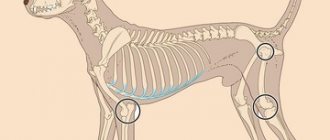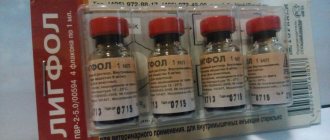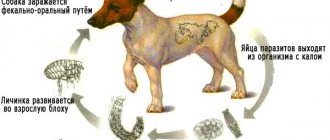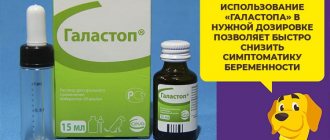Medicines for animals > Dexamethasone (injection solution)
Brief description:
Dexamethasone is a synthetic glucocorticoid, contains dexamethasone disodium phosphate as the active substance and is characterized by effective anti-inflammatory, antishock, immunosuppressive, antiallergic and antitoxic effects. The drug is prescribed to animals for the following pathological conditions: spinal cord injury, allergies of various origins, shock conditions, intoxication, bursitis, arthritis, tendovaginitis, tendinitis, acetonemia, puerperal paresis of cattle, edematous disease of pigs, toxic agalactia (a specific type of obstetric sepsis).
For whom:
the drug is used to treat horses, pigs, various types of ruminants, cats, dogs.
Leave form:
The medicine is produced in the form of a colorless or yellowish transparent solution for injection, packaged in dark glass ampoules.
Dosage:
Dexamethasone is used intramuscularly, periarticularly (around the joint), locally intraarticularly (inside the joint), intrabursally (directly into the joint capsule). In case of shock, the solution is administered once. For infectious diseases, the drug is used simultaneously with antibiotics. The duration of therapy and dose are determined by the veterinarian individually. The treatment regimen depends on the diagnosis, the animal’s body weight and the severity of the pathological process.
Restrictions:
Contraindications to the drug are diabetes mellitus, bone fractures, and pregnancy. For a single use for health reasons, the only contraindication is hypersensitivity to the components. If the prescribed treatment regimen is strictly followed, Dexamethasone is well tolerated by animals. However, in some cases, the development of certain side effects is possible, namely: decreased or increased appetite, gastrointestinal perforation, gastrointestinal bleeding, flatulence, steroid ulcer of the gastric mucosa, erosive esophagitis; heart rhythm disturbances, thrombosis, increased blood pressure; damage to the optic nerve due to increased intraocular pressure, hypocalcemia, weight gain; thinning of the skin, itching, anaphylactic shock, convulsions. When using the drug, it is necessary to monitor the animal’s blood pressure, glucose levels, and water and electrolyte balance. It is also recommended to carry out X-ray monitoring of the condition of bones and joints.
DEXAMETHASONE Solution for injectionCompound. 1 ml of solution contains 4 mg of dexamethasone-21-phosphate (disodium salt).
Action.
Dexamethasone has a pronounced anti-inflammatory, antiallergic and gluconeogenetic effect.
Dexamethasone is a long-acting glucocorticoid (over 48 hours) after a single dose.
Indications.
Treatment of various diseases in cattle, pigs, horses and carnivores - shock, spinal cord injury, allergic diseases, arthritis, tendinitis, tenosynovitis, bursitis. In addition, treatment of ketosis (acetonemia), puerperal paresis in cattle, as well as MMA syndrome, intoxication, stress conditions and edema disease in pigs.
Application.
The drug is administered intramuscularly, locally applied intraarticularly, periarticularly and intrabursally. Injections in the mentioned doses can be repeated after 3 or 4 days.
Doses.
The drug is administered parenterally in the following doses: horses, cattle - 5 ml; pigs - 2 - 3 ml; piglets - 0.5 - 1 ml; dogs, cats - 0.5 - 1 ml; locally: horses, cattle - 2 - 5 ml; pigs - 1 - 2 ml; dogs, cats - 0.5 - 1 ml.
Treatment lasts 3 days. It can be extended as needed.
For antishock therapy, a single dose of 1 - 1.5 ml of solution (4 - 6 mg of dexamethasone) per 1 kg of body weight is administered intravenously. At the same time, therapeutic measures are carried out aimed at replacing fluid lost by the body.
For spinal cord injury, administer 0.5 ml of solution (2 mg of dexamethasone) per 1 kg of body weight every 8 hours until improvement occurs (but not more than one day).
Contraindications.
Do not give during the last trimester of pregnancy, with diabetes, or bone fractures.
Precautionary measures.
For infections, dexamethasone is used only in combination with antibiotics or other chemotherapeutic agents. In this case, the possibility of an outbreak of usually latent infections during treatment with dexamethasone should be taken into account, so precautions should be taken.
If necessary, prescribe dexamethasone to pregnant animals, animals with heart failure, as well as those suffering from certain kidney diseases (protein loss), and young animals. Treatment should be carried out under strict supervision.
Package.
Bottles of 10 ml, boxes of 10 ampoules of 2 ml and boxes of 10 ampoules of 5 ml.
The drug is produced by Lek, Ljubljana, Slovenia.
Instructions for use of Dexamethasone for cats and kittens
According to the instructions, “Dexamethasone” for cats is a drug that is a substitute for the hormone cortisol produced by the adrenal cortex. The medicine has a whole range of features in use, contraindications and undesirable effects, so it can be used only after reading the instructions developed for it by the manufacturer.
General description of the drug
The production of Dexamethasone is carried out by several pharmaceutical companies (Belarus), KRKA (Slovenia), Alfasan International (Netherlands) and others. The drug is a transparent yellowish or colorless solution with a slight specific odor. The medicine is packaged in glass ampoules of 1 or 2 ml. It goes on sale in blister packs or cardboard packs. Each of them contains from 5 to 25 ampoules with Dexamethasone for cats and instructions for their use.
The manufacturer recommends storing the drug away from feed and food, in a place where animals and small children cannot reach. The packaging should not be heated to a temperature of 25 °C or higher. If these conditions are met, the medicine retains its pharmaceutical properties for 3 years. After this period, unused remains of the solution must be disposed of.
"Dexamethasone" is sold not only in veterinary, but also in regular pharmacies. The price of the solution depends on the volume of the medicine in the package and varies from 150 to 340 rubles. To purchase medication, you need a prescription form filled out by a veterinarian.
Description of the drug Dexamethasone
Dexamethasone is a gluconeogetic drug (glucocorticosteroid) that is used to relieve inflammatory processes, against edema and allergies. Dexamethasone is available in every industrialized country. The veterinary version (Dexamethasone 2 mg/cm3) is produced by the Dutch (Netherlands, Verdun). This drug is available without a veterinarian's prescription, making it popular among cat and other pet owners.
Alfasan also produces other popular drugs for veterinary use (Alfacain, Kanamycin, Xylazin, Neurotrank, Streptopen, etc.).
In addition to Dexamethasone, Alfasan produces a wide range of other drugs intended for the treatment of domestic and farm animals
Release form and composition of the drug
In the Netherlands, Dexamethasone is available as an injection solution, but there are other dosage forms of this drug. So, cat owners and veterinarians use eye drops from different manufacturers. Dexamethasone tablets are also produced (intended for treating humans), but they are rarely used in cats.
Solution for injection Dexamethasone 2 mg
Dexamethasone injection solution is a clear liquid (without color or with a yellowish tint). It is packaged in brown glass bottles of 50 or 100 ml. Each container is sealed with a rubber stopper and covered with a metal cap (this ensures sterility). For convenience, each box includes instructions for using the solution. One 50 ml bottle can cost up to 200 rubles.
When my sister was looking for veterinary Dexamethasone for her cat, it was not available in pet pharmacies. Then we had to go to the regular on-duty pharmacy. The “human” version is also available in ampoules (1 and 2 ml), which are folded into blisters (from 5 to 25 pieces). We found a pack of 10 ampoules. But there is a nuance here - the concentration of the active substance in such a solution is twice as high as in a veterinary one. The vet allowed us to use this medicine, but he had to recalculate the dosage.
Composition of 1 ml solution:
- dexamethasone (in the form of disodium phosphate) - 2 mg;
- sodium metabisulfite - 1 mg;
- methyl parahydroxybenzoate - 1 mg;
- propyl parahydroxybenzoate - 0.1 mg;
- disodium phosphate dodecahydrate - 13.5 mg;
- water for injections.
Veterinary Dexamethasone is sold only in bottles with a cap and only with a concentration of 2 mg/ml
Tablet form
Dexamethasone tablets have a flat-cylindrical shape with a chamfer on one side. They are packaged in foil blisters or darkened bottles with a threaded plastic cap. Each unit is packed in a cardboard box, which includes an annotation. A plate of 10 tablets can cost from 17 rubles.
Composition of the drug in tablet form:
- dexamethasone (500 mcg in 1 tablet);
- ancient acid - 0.0015 g;
- potato starch - 0.0340 g;
- sucrose - 0.1140 g;
- silicon dioxide dry.
Interesting fact: dexamethasone as an active ingredient is contained in many drugs. In 2008, Russian biathlete, champion of the summer biathlon world championships Tatyana Moiseeva was accused of doping. The scandal occurred after a doping test in which dexamethasone was detected. After this, WADA (the world anti-doping agency) added the drug to the list of prohibited drugs among athletes. After a detailed doping analysis, it turned out that Moiseeva used eye drops with this substance, but the scandal affected the biathlete’s future career.
Dexamethasone tablets are easier to find than veterinary injection solution, but they are more difficult to determine the dosage
Ophthalmic drops
Dexamethasone eye drops are a cloudy liquid (similar to a suspension) packaged in bottles made of soft polymer material. Each bottle is equipped with a dropper cap and packed in a cardboard box. Drops are sold in containers of 5 or 10 ml. The price of such a drug can range from 30 to 150 rubles per 10-ml bottle.
Surprisingly, some Dexamethasone is in beautiful packaging. I have only seen bottles of a standard shape in pharmacies, but once (at a friend’s house) I saw a bottle in the shape of an old oil can (a flat bottle with a curved dropper). It was an imported drug brought by relatives.
Composition of 1 ml solution for instillation:
- dexamethasone (1 mg);
- boric acid;
- sodium tetraborate;
- trilon B;
- preservative;
- injection water.
In some cases, the suspension may separate and form a sediment, but this can be easily corrected with vigorous shaking.
Storage conditions for veterinary drugs
Dexamethasone in any dosage form is recommended to be stored under the following conditions:
- in sealed manufacturer's packaging;
- separately from food and feed;
- in a dry place, protected from direct sunlight;
- at temperatures from 4°C to 25°C;
- in places inaccessible to children;
- Dexamethasone should not be used after the expiration date.
Expiration dates vary depending on the form of release. The injection solution in a sealed container is stored for up to 3 years from the date of release, and after opening the package - 3 weeks. Tablets and drops can be stored for 5 years. If the seal of the drops is broken, the shelf life is reduced to 4 weeks.
The ideal place to store medicine is a separate first aid kit.
Composition and pharmaceutical properties
The active component of the drug is dexamethasone phosphate (in the form of sodium salt). This compound is a synthetic glucocorticosteroid hormone (methylated derivative of fluoroprednisolone) with antiallergic, anti-inflammatory and immunosuppressive properties. In addition, it is able to increase the sensitivity of beta-adrenergic receptors to catecholamines produced by the animal’s adrenal glands.
The anti-inflammatory effect of the drug is associated with inhibition of the production of inflammatory mediators by mast cells and eosinophils. It is also based on:
- acceleration of lipocortin synthesis;
- reduction in the number of mast cells capable of producing hyaluronic acid;
- decreased vascular permeability;
- stabilization of cell membranes and organelles.
The immunosuppressive properties of the drug are due to the destruction of lymphoid tissues, inhibition of the production of lymphocytes, slowing down the process of cytokine release and reducing the formation of antibodies. In turn, the antiallergic effect develops against the background of a decrease in the synthesis of allergy mediators and a decrease in the sensitivity of effector cells to them, inhibition of the release of histamine from basophils and mast cells, suppression of the development of connective tissue and changes in the body’s immune response mechanism.
Along with the active components, Dexamethasone includes a whole complex of substances that perform auxiliary functions. These include sodium metabisulfate and hydroxide, purified water for injection, propylparaben, disodium edetate and methylparaben.
Indications for use
In veterinary medicine, Dexamethasone is used to treat autoimmune, allergic and inflammatory diseases. Most often, indications for prescribing this medication are:
- bronchial asthma;
- anaphylactic shock;
- allergic eczema;
- lupus erythematosus;
- Quincke's edema;
- atopic or allergic dermatitis;
- traumatic shock;
- spinal cord injuries;
- intervertebral hernia;
- autoimmune disorders in joints;
- swelling of lung tissue;
- inflammatory processes that developed against the background of injuries;
- brain tumors;
- lymphoma;
- otitis;
- thrombocytopenia;
- blepharitis, conjunctivitis, keratitis and other ophthalmological pathologies;
- urolithiasis disease;
- arthritis, arthrosis, bursitis;
- adrenal diseases;
- disorders in the musculoskeletal system;
- leukemia and other oncological diseases.
In addition, Dexamethasone is used to relieve allergic reactions to the use of other medications.
Indications for use
global $ads_google;
//data-ad-slot=”2475549904″ $ads_google = empty($ads_google) ? false : true; ?> if ($ads_google == false) {?> $ads_google = true; ?> } ?> If you read the instructions, it becomes clear why the tool is so popular. The medicine can be used if the cat has:
- bursitis;
- arthritis;
- intervertebral hernia;
- pathology of the musculoskeletal system;
- eczema;
- allergic dermatitis;
- bronchial asthma;
- lupus erythematosus;
- leukemia;
- allergies to medications;
- cancer;
- anaphylactic shock;
- Quincke's edema;
- injuries and swelling after injuries.
As you can see, it makes sense to keep several ampoules in your veterinary kit.
Dexamethasone is prescribed to cats if their adrenal glands do not secrete certain hormones. When a cat begins to have eye problems, such as conjunctivitis, keratitis, blepharitis or keratoconjunctivitis, they purchase the product in the form of eye drops. They act as an anti-inflammatory medicine for diseases of the organs of vision of non-infectious origin.
Application procedure
Dexamethasone is rarely used as an independent remedy. Most often it is prescribed in combination with other veterinary drugs - Rimadyl, Cyclosporin, Digoxin, Aspirin, Mitotane, Amphotericin, Phenobarbital, Cyclophosphamide or Insulin. The medicine is administered intramuscularly using a sterile syringe (injecting the solution subcutaneously is prohibited). In this case, the cats are kept strictly in a horizontal position.
The dosage and frequency of use of Dexamethasone is determined by the doctor individually for each pet. The veterinarian must take into account the diagnosis, weight and age of the cat. For example, in case of anaphylactic shock, the medicine is administered once (1.5 ml of solution per 1 kg of animal weight). At the same time, for inflammatory diseases, injections are given 2 times a day for a week. The dose is determined at the rate of 0.5 mg per 1 kg of pet’s body weight.
Dexamethasone is prescribed to kittens only after reaching puberty, that is, at the age of 7-9 months and older. The treatment regimen is drawn up by a veterinarian (there are no general instructions for the use of the drug in such cases). At the same time, the doctor takes into account that in kittens the risk of side effects from using the medicine is much higher than in adult pets.
If the recommended dose of Dexamethasone is exceeded by 2 times or more, cats develop an overdose. This pathological condition manifests itself:
- changes in the behavior of your pet (apathy, constant drowsiness, lethargy);
- vomiting;
- nausea;
- increased appetite;
- a sharp increase in fluid consumption;
- frequent urination;
- diarrhea and other stool disorders;
- shortness of breath.
Symptoms of systematic overdoses may include ulceration of the digestive tract, as well as increased susceptibility to viral and bacterial infections.
Instructions for the use of Dexamethasone in veterinary medicine for the treatment of cats
The dose of medication in veterinary medicine varies depending on the pathology. It is determined based on the severity of the disorder, the condition of the body and the duration of therapy.
Anti-inflammatory injection doses for cats range from 0.1 to 0.5 mg per kilogram up to twice daily.
The immunosuppressive dosage for a cat can be from 1 to 6 mg per kilogram up to three times a day.
The course of treatment depends on the pathological condition, response to the drug and the development of any adverse effects.
Even if your pet begins to feel better immediately, the treatment plan must be followed through to completion. This will minimize the risks of relapse and prevent the development of withdrawal syndrome. Withdrawal syndrome is a sharp return of all symptoms of a previous disease due to early drug withdrawal.
Dexamethasone is prescribed to kittens upon reaching puberty. That is, approximately 7-9 months. The course of treatment is determined by the doctor depending on the pathology. The risk of side effects is higher in kittens.
Before using the drug in the form of ophthalmic drops, shake the bottle and rinse your eyes. Apply the drug at room temperature to the inner corner of the eye. The procedure is repeated 3-5 times a day. The duration of treatment is determined by the veterinarian. On average, the course of treatment is no more than 14 days.
This medication should never be used without first consulting your veterinarian.
Contraindications and side effects
The manufacturer's instructions for using Dexamethasone injections for cats state that the drug has a wide range of contraindications. In particular, the medicine is not prescribed to pets who have previously been diagnosed with:
- renal or liver failure;
- some diseases of the cardiovascular system;
- diabetes;
- allergic reactions to components present in the drug.
In addition, Dexamethasone is contraindicated in elderly, pregnant and lactating cats, animals that have recently been vaccinated or are preparing for vaccinations. It is prohibited to use the medicine while taking tablets with hypoglycemic properties and some diuretics. In addition, it is important to consider that the effect of Dexamethasone is weakened when combined with rifampicin, phenytoin, barbiturates, aminoglutethimide and carbamazepine.
Contraindications
The veterinarian should first of all find out from the owners whether the cat is currently being given any other medicine, since not all of them are compatible with each other.
The product is contraindicated for pregnant and lactating cats, as well as for cats before and after vaccination.
You will have to act more carefully if the cat has kidney and liver failure, or diseases of the cardiovascular system.
If the pet is elderly or has diabetes, the drug is prescribed in rare cases.
Indications for use of the medicine
Dexamethasone is used in veterinary medicine in cats for the following health problems:
- bronchial asthma;
- eczema;
- intervertebral hernia, arthritis, bursitis;
- allergic reaction;
- inflammatory process as a result of injuries;
- swelling;
- lupus erythematosus;
- urolithiasis disease
- cancer and other diseases.
Dexamethasone - injection solution
Important! Veterinarians recommend purchasing several ampoules for your home first aid kit, because this drug effectively helps with Quincke's edema or anaphylactic shock, which can occur suddenly.
In addition to all the above problems, the medicine is used if the adrenal cortex does not secrete the necessary hormone, but in this case, only a veterinarian prescribes Dexamethasone to the cat with the required injection dosage.
The big advantage of the drug is its versatility in use. He provides first aid during a state of shock after an accident, after a fall or other serious injuries.
Dexamethasone is also available in the form of eye drops, which will help with:
- blepharitis;
- conjunctivitis;
- keratitis and other problems.
Medicine in drops
Indications for use of the drug
The glucocorticosteroid Dexamethasone is usually prescribed to treat the following pathologies:
- post-traumatic edema;
- anaphylactic shock;
- arthritis, arthrosis, rheumatism;
- tendovaginitis;
- eczema and allergies;
- otitis, conjunctivitis, blepharitis;
- diseases of the nervous and respiratory systems;
- inflammatory gastrointestinal pathologies;
- adrenal insufficiency.
Operating principle
The mechanism of action of the drug depends on the dosage form, but the pharmacological effect is the same. Dexamethasone can relieve inflammation and stop allergic reactions. This drug also increases immunosuppressive activity and relieves swelling. All this is achieved through blocking inflammatory mediators and increasing the production of lipocartins (they are responsible for reducing swelling). In addition, in the body into whose blood Dexamethasone has entered, the permeability of the capillary walls decreases. The injection solution penetrates into the blood through soft tissues, tablets through the gastrointestinal mucosa, drops through the superficial layers of the cornea. The fastest maximum concentration of the active substance in the blood (after 1 hour) occurs after injection.
I became interested in how Dexamethasone is used for adrenal disease, and I turned to Bulat, an agricultural veterinarian. He explained to me that this drug does not treat the adrenal glands, but the glucocorticosteroid is often used for various tests. For example, you can check whether your adrenal glands are functioning properly with a large dexamethasone test. This is the easiest way to identify Cushing's syndrome. And with the help of this test, you can distinguish a neoplasm of the adrenal cortex from the “enlarged gland” syndrome. Most often, such screening is performed on cattle.
Due to its properties, the active substance, dexamethasone, is used not only for the treatment of diseases, but also for conducting screening tests
Effect of the drug
Dexamethasone (injections) for cats relieves inflammation in the body and also has antiallergic and immunosuppressive effects. During the destruction of body cells, prostaglandins are released, which this medicine suppresses.
The main component of the drug is a synthetic hormone. It is similar to the hormone that is secreted by the adrenal cortex and is necessary for the full functioning of the entire body. It has a positive effect on the endocrine and nervous systems, on joints, and also takes part in many physiological processes.
One of the main features of the drug is that it is able to suppress certain types of receptors. It is because of this that the allergic reaction begins to recede, because the animal’s body stops responding to the irritant.
Important! The instructions for use say that the dosage of a dexamethasone injection for cats is calculated exclusively by a veterinarian. Excessive amounts of the drug can lead to serious consequences.
Dexamethasone injections are used in this form, because the drug composition penetrates the blood faster and helps to cope with the state of shock that arose due to an injury or an allergic reaction. But as for the tablet form of the drug, the active substance can only be absorbed into the blood by 50%.
Dosage and use of Dexamethasone
The form of the drug Dexamethasone and the required dose are prescribed exclusively by the veterinarian after performing a clinical examination of the cat, as well as, if necessary, additional studies (blood test, ultrasound, x-ray, etc.). The volume of a single use of the drug for each individual case is selected individually and can range from 0.1 ml to 1.0 ml per kg of cat weight (if injections are prescribed). There is practically no difference between tablets and injections, except that the latter provide a more rapid effect of the drug. Therefore, if we are talking about urgent intervention, then an injection is given, and therapeutic treatment may well take place on tablets.
Injections are given intramuscularly, into a vein or subcutaneously. If the owner knows how to install them, then he does not need to take the animal to the clinic every time. On the contrary, such visits create additional stress for the cat, so the manipulation can be safely performed at home, following the regimen and dosage. If the injection was missed according to the schedule, then you should do it as soon as possible, and then follow the schedule. It is strictly forbidden to administer two doses of Dexamethasone to a cat at the same time.
Dexamethasone injections for cats are given with a solution at room temperature, if it is stored in the refrigerator, but before that it should be warmed by holding it in a clenched fist for five to ten minutes, there is no need to dilute it, the solution is completely ready for use. The syringe, of course, must be disposable and sterile; they cannot be reused. Before starting the procedure, hands are washed with soap, the injection site is wiped with cotton wool soaked in alcohol, and Dexamethasone-Ferein is administered smoothly. After the injection, you can lightly massage the area where the medicine was injected so that it “disperses” better and the cat does not have bumps.
The standard course of treatment takes 5-7 days. The first injection should be given in the clinic, which you should not leave for half an hour after the procedure; this precaution is aimed at ensuring that if the cat has any adverse reaction to Dexamethasone, doctors will immediately provide qualified assistance within the walls of the veterinary institution.
© shutterstock
Instructions for use of different dosage forms of the drug
To relieve the inflammatory process, veterinarians recommend using this particular drug, following the instructions for use.
Dexamethasone - dosage for cats in different situations:
- for anaphylactic shock, the dose per 1 kg of animal weight is 1.5 ml;
- for spinal injuries 0.5 ml per 1 kg;
- For infectious diseases, the drug is prescribed by a veterinarian in combination with antibiotics.
The medicine must be given to the animal only when it reaches puberty, which is around 7-9 months. Before this age, Dexamethasone should not be given. The dosage for cats is calculated only by the attending physician, based on the stage of development of the inflammatory process and other health problems.
What diseases are indications for use in cats?
Dexamethasone is given to cats to treat pathological conditions of an allergic, inflammatory and autoimmune nature. It helps achieve positive dynamics in treatment:
- allergic eczema;
- atopic/allergic dermatitis;
- allergic reactions to medications;
- lupus erythematosus;
- bronchial asthma of cats;
- Quincke's edema and lungs;
- anaphylactic or traumatic shock;
- inflammation as a result of injury;
- autoimmune joint pathologies;
- spinal cord injuries;
- brain tumors, lymphoma (leukemia);
- thrombocytopenia;
- otitis media;
- ophthalmological problems (conjunctivitis, keratitis, blepharitis of various etiologies).
Indications for treating animals with medicine in the form of eye drops are conjunctivitis, inflammation of the ciliary zone and tear ducts and other diseases of the organs of vision. This drug is often prescribed after surgery by an ophthalmologist. It relieves allergic manifestations such as swelling, itching, and redness well.
Conjunctivitis Inflammation of the ciliary zone Eczema Dermatitis
Contraindications and side effects
If Dexamethasone is given to a cat in ampoules according to the instructions, then no side effects should occur. But there are still several contraindications for use:
- problems with the gastrointestinal tract;
- hormonal imbalance in the body;
- poor eyesight;
- heart problems;
- allergy to one of the components of the drug;
- diabetes.
Dosage form of the drug
It is also prohibited to use eye drops for viral or fungal infections. And since it is impossible to independently determine the presence of a particular disease, it is necessary to seek advice from a specialist.
Storage conditions of the drug
The medicine must be stored in a safe place away from children and animals. The air temperature should be no higher than 25 degrees. You can also store the liquid in a syringe in the refrigerator, but no longer than 24 hours.
Important! Drops for eyes and ears come in a small bottle with a pipette at the tip. After the drug has been used, its shelf life in this form is no more than 30 days. Before you start using the drops, the bottle must be shaken thoroughly.
Interaction with other drugs of medicinal origin
Before giving other drugs in parallel with Dexamethasone, you should consult a veterinarian, because combining the drug with some medications is prohibited in order to avoid negative consequences:
- reduces the effect of insulin drugs;
- parallel use with diuretics promotes rapid removal of potassium from the body;
- when used with aspirin leads to bleeding and ulcers;
- It is necessary to give the medicine in ampoules only three weeks after the animal’s vaccination, because it can suppress the animal’s immunity.











